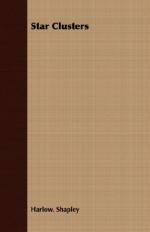|
This section contains 380 words (approx. 2 pages at 300 words per page) |
 Harlow Shapley discovered that the solar system does not rest in the center of the Milky Way, but is actually located in the outer regions of the galaxy.
Harlow Shapley discovered that the solar system does not rest in the center of the Milky Way, but is actually located in the outer regions of the galaxy.
Astronomer 1885-1972
Harlow Shapley was born on November 2, 1885, in Nashville, Missouri. He worked for a newspaper in Kansas and later attended the University of Missouri, intending to study journalism, but taking up astronomy instead. In 1911 Shapley went to Princeton University, where he worked with Henry Norris Russell on eclipsing binary stars. After completing his doctoral thesis, Shapley began work at Mt. Wilson Observatory in California in 1914, where he studied Cepheid variables. Brighter Cepheids have longer periods, and Shapley was able to determine the distances to faint Cepheids and show that the Milky Way galaxy was far larger than previously believed.
Shapley's most important contribution to astronomy was to note that the globular clusters were concentrated toward the constellation Sagittarius, and he made the correct assumption that the center of this concentration marked the center of the Milky Way. He thus moved the universe from a Copernican Sun-centered system to a Sun located far from the galactic center in one of the spiral arms.
On April 20, 1920, a famous debate was held between Shapley and fellow astronomer Heber Curtis on the subject of "The Scale of the Universe." Curtis was correct in arguing that spiral nebulae were galaxies like our own but incorrect in placing the Sun at the center of the Milky Way. Shapley was correct in placing the Sun far from the center of the Milky Way but incorrect in saying the spiral nebulae were nearby gas clouds.
In 1920 Shapley was offered the directorship of the Harvard College Observatory, where he stayed for the rest of his career. He died in Boulder, Colorado, on October 20, 1972. Shapley's legacy as a popularizer of astronomy is maintained by the American Astronomical Society's Harlow Shapley Visiting Lectureships Program, which sends astronomers on twoday visits to universities and colleges in the United States, Canada, and Mexico.
See Also
Astronomy, History of (Volume 2);; Copernicus, Nicholas (Volume 2);; Galaxies (Volume 2);; Stars (Volume 2).
Bibliography
Grindlay, Jonathan E. and A. G. Davis Philip, eds. The Harlow Shapley Symposium on Globular Cluster Systems, IAU Symposium No. 126. London, UK: Kluwer, 1988.
Shapley, Harlow. The View from a Distant Star. New York: Basic Books, 1963.
|
This section contains 380 words (approx. 2 pages at 300 words per page) |


